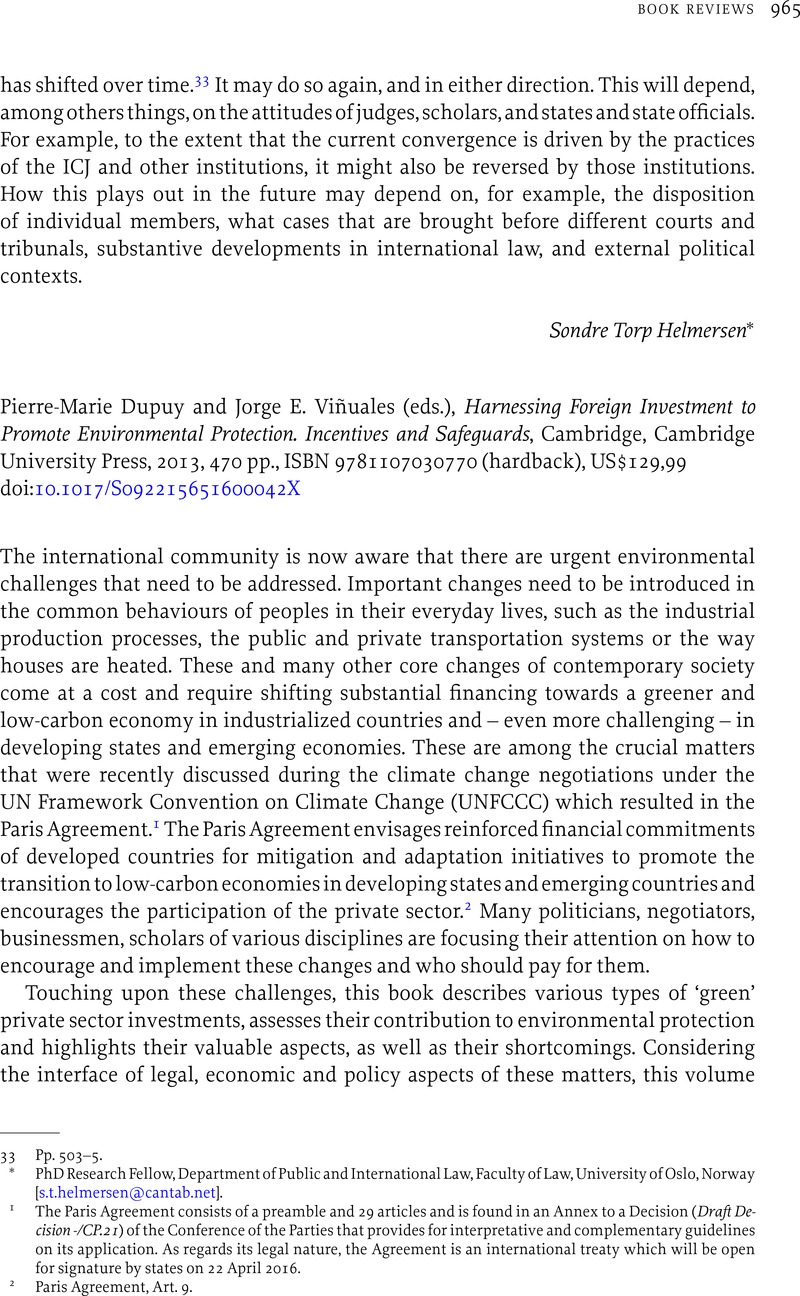No CrossRef data available.
Published online by Cambridge University Press: 28 July 2016

1 The Paris Agreement consists of a preamble and 29 articles and is found in an Annex to a Decision (Draft Decision -/CP.21) of the Conference of the Parties that provides for interpretative and complementary guidelines on its application. As regards its legal nature, the Agreement is an international treaty which will be open for signature by states on 22 April 2016.
2 Paris Agreement, Art. 9.
3 Dupuy, P.-M., ‘International environmental law: looking at the past to shape the future’, in Dupuy, P.-M. and Viñuales, J.E. (eds.), Harnessing Foreign Investment to Promote Environmental Protection. Incentives and Safeguards (2013), 9 CrossRefGoogle Scholar at 20 identifies as one of the challenges the soft and hard law distinction and the ‘partitioning of legal orders’.
4 F. Francioni, ‘The private sector and the challenge of implementation’, in Dupuy and Viñuales (eds.), supra note 3, 24, at 30, the author traces possible ways forward to better address the challenges of implementation of international environmental law, among which he suggests reconsidering the concept of state sovereignty in a ‘functional’ and ‘responsible’ perspective.
5 P.-M. Dupuy and J.E. Viñuales, ‘Introductory Observations’, in Dupuy and Viñuales (eds.), supra note 3, 1 at 5.
6 Ch. 14.
7 B.J. Richardson, ‘Socially responsible investing through voluntary codes’, in Dupuy and Viñuales (eds.), supra note 3, 383 at 386.
8 Ch. 4.
9 S. Maljean-Dubois and V. Richards, ‘The applicability of international environmental law to private enterprises’, in Dupuy and Viñuales (eds.), supra note 3, 69, at 74 and 81.
10 Ch. 12.
11 On this matter, see also Maljean-Dubois and Richards, ibid., at 89. Transparency of initiatives undertaken by states for climate change mitigation and adaptation and climate finance is also a central ingredient in the Paris Agreement (art. 14) which should enhance the comparability of the action taken.
12 E. Morgera, ‘From corporate social responsibility to accountability mechanisms’, in Dupuy and Viñuales (eds.), supra note 3, 321 at 326.
13 Ch. 6
14 M.J. Langer, ‘Key instruments of private environmental finance: funds, project finance and market mechanisms’, in Dupuy and Viñuales (eds.), supra note 3, 131 at 152–3.
15 See, for instance, Morgera, supra note 12, at 328 noting that: ‘when stakeholder consultations are the responsibility of the host government, the client is expected to conduct a complementary process if the government-led engagement does not meet the policy and performance standards of the IFC’.
16 Morgera, supra note 12, at 340 referring to the case of the NGO OECDWatch which considering inadequate the implementation of the OECD Guidelines, produced quarterly updates on the filing, conclusion or rejections of instances.
17 Ch. 13.
18 Ch. 8.
19 Ch. 9.
20 Ch. 15.
21 Z. Douglas, ‘The enforcement of environmental norms in investment treaty arbitration’, in Dupuy and Viñuales (eds.), supra note 3, 415 at 435.
22 Maljean-Dubois and Richards, supra note 9, at 90–2.
23 See Douglas, supra note 21, at 438 exploring the possibility that investment arbitral tribunals have the power to operationalize international environmental norms by translating them into standards.
24 J.E. Viñuales, ‘The environmental regulation of foreign investment schemes under international law’, in Dupuy and Viñuales (eds.), supra note 3, 273, at 301.
25 Defined by the author as ‘the transfer of production to parts of the world that are less constraining than the countries of origin’. (U. Luterbacher, ‘The political environment of environmental law’, in Dupuy and Viñuales (eds.), supra note 3, 50 at 54).
26 Luterbacher, ibid., at 58.